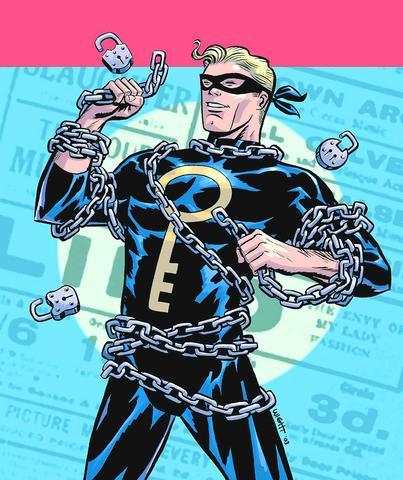The comic book industry has a new writer, and his name is Michael Chabon.
Dark Horse Comics published Michael Chabon Presents: The Amazing Adventures of the Escapist last month. That quarterly anthology features the hero from Chabon's novel The Amazing Adventures of Kavalier & Clay, which won the Pulitzer Prize in 2001. In writing the lead story in the first issue, Chabon has leaped from the comics imagined in his novel to producing the real thing.

PHOTO: NY TIMES
Chabon joins a growing number of novelists, as well as writers from film and television, who are delving into the genre.

PHOTO: NY TIMES
This month Greg Rucka, the author of a series of novels about a professional bodyguard, will have several comic book stories published. They range from Wonder Woman and The Adventures of Superman, published by DC Comics, to Wolverine, from Marvel Comics.
In June Brad Meltzer, who writes thrillers, will have his second comics work in stores. DC plans to publish the first chapter of his Identity Crisis, a seven-part mystery about a murder in the superhero community.
At Marvel, Astonishing X-Men, written by Joss Whedon, the creator of Buffy the Vampire Slayer, is to be released in May. And Bryan Singer, director of the X-Men films, will begin a run in Ultimate X-Men later this year.
For the comics industry, the payoff is immediate. "The first thing we get is good, exciting comic-book stories," said Dan DiDio, the DC Comics vice president for editorial. "It could bring people back or bring them to comics for the first time."
He added, "It also gives us a chance to get a fresh set of eyes and a fresh take on our characters."
Part of the appeal for Chabon is that the genre operates on many different levels. "High art and low art, children's reading and adult's reading, the margins of trash and quality," he said in a telephone interview. He added, "Comic books have always been border straddling, even, fundamentally, between words and pictures. There's something stimulating about hanging out at the borders there."
One conceit of the Escapist comic books is that the stories are reprints from the decades-long run of the superhero invented by Kavalier and Clay, who in turn were thought up by Chabon. The first issue includes an elaborate text piece about the Escapist's history. Of course all the stories are being written and drawn for the first time.
"I was trying to create a pleasurable sense of doubt in the reader's mind about how made-up all this was," Chabon said. He compared the experience to seeing a magician at work. "You know he's not actually sawing anyone in half," he said. "You just end up enjoying the illusion."
Chabon was offered plenty of control on the comic and the possibility of working with many artists and writers: "It's just been such a thrill to see characters I dreamed drawn by people like Gene Colan, Howard Chaykin, and written by guys like Marv Wolfman -- the artists and writers that I grew up idolizing."
So how often will readers be treated to Escapist adventures by Chabon? "Whenever time and inspiration permit," he said.
Rucka tries to divide his time evenly between comics and novels. His first book, Keeper, was published in 1996 and his first comics work, Whiteout, came two years later. These days Rucka is writing Queen & Country, a comic book series, for Oni Press and is wrapping up a run on Wolverine for Marvel. He recently signed an exclusive contract with DC to write Wonder Woman and other projects, and he has a novel due for release in September.
"Comics are short form. In their own way they're like writing a short story," Rucka said. "I can work with comics fairly easily and fairly fluidly. When I'm working on a novel, it requires as much concentration and discipline as I can muster."
In the twist for Rucka, his new spy novel is a further examination of the intelligence agency he created in Queen & Country. That series has at least 7,000 readers who buy it from issue to issue, Rucka said, and about four times that number who read it in trades, a thicker comic-book format that collects entire story lines. For the prose version of Queen & Country, A Gentleman's Game, Rucka had to strike a balance between giving fans something new and making it accessible to newcomers.
Readers could tell that Meltzer was a comics enthusiast right from the start. There are superhero references in many of his novels, including his latest, The Zero Game, which had its debut last month at No. 3 on the New York Times best-seller list. Meltzer's first comic-book project was Archer's Quest, a six-part Green Arrow story. Meltzer inherited the comic book from the filmmaker Kevin Smith, whose tenure raised Green Arrow from second-string hero to one of DC's top sellers.
Writing comic books is "the ultimate 11-year-old fantasy," Meltzer said. "When they first offered me the job, I was going to say no, but my wife said to me, `Moron, you've been waiting your whole life for this.' As always, my wife was a lot smarter than me."
While Meltzer's stint on Green Arrow was well received, he still came close to turning down a second opportunity to write for DC. "I was going to say no and I had a breakthrough," Meltzer said. He had found a human -- rather than superhuman -- idea for the story and so Identity Crisis was born. For Meltzer, this is a chance to tell the kind of story that appealed to him as a comic-book fan, tales that weren't "about capes and utility belts, but were about the people behind the masks."
The Identity Crisis mystery involves the biggest DC heroes and will use all of Meltzer's skills as a thriller novelist.
"How do you hide from a man who can see through walls? How do you lie to a woman who has a magic lasso that can make you tell the truth?" Meltzer asked.
His answer: "I used everything I learned from one genre and applied it to another."

In the next few months tough decisions will need to be made by the Taiwan People’s Party (TPP) and their pan-blue allies in the Chinese Nationalist Party (KMT). It will reveal just how real their alliance is with actual power at stake. Party founder Ko Wen-je (柯文哲) faced these tough questions, which we explored in part one of this series, “Ko Wen-je, the KMT’s prickly ally,” (Aug. 16, page 12). Ko was open to cooperation, but on his terms. He openly fretted about being “swallowed up” by the KMT, and was keenly aware of the experience of the People’s First Party

Aug. 25 to Aug. 31 Although Mr. Lin (林) had been married to his Japanese wife for a decade, their union was never legally recognized — and even their daughter was officially deemed illegitimate. During the first half of Japanese rule in Taiwan, only marriages between Japanese men and Taiwanese women were valid, unless the Taiwanese husband formally joined a Japanese household. In 1920, Lin took his frustrations directly to the Ministry of Home Affairs: “Since Japan took possession of Taiwan, we have obeyed the government’s directives and committed ourselves to breaking old Qing-era customs. Yet ... our marriages remain unrecognized,

During the Metal Ages, prior to the arrival of the Dutch and Chinese, a great shift took place in indigenous material culture. Glass and agate beads, introduced after 400BC, completely replaced Taiwanese nephrite (jade) as the ornamental materials of choice, anthropologist Liu Jiun-Yu (劉俊昱) of the University of Washington wrote in a 2023 article. He added of the island’s modern indigenous peoples: “They are the descendants of prehistoric Formosans but have no nephrite-using cultures.” Moderns squint at that dynamic era of trade and cultural change through the mutually supporting lenses of later settler-colonialism and imperial power, which treated the indigenous as

Standing on top of a small mountain, Kim Seung-ho gazes out over an expanse of paddy fields glowing in their autumn gold, the ripening grains swaying gently in the wind. In the distance, North Korea stretches beyond the horizon. “It’s so peaceful,” says the director of the DMZ Ecology Research Institute. “Over there, it used to be an artillery range, but since they stopped firing, the nature has become so beautiful.” The land before him is the demilitarized zone, or DMZ, a strip of land that runs across the Korean peninsula, dividing North and South Korea roughly along the 38th parallel north. This